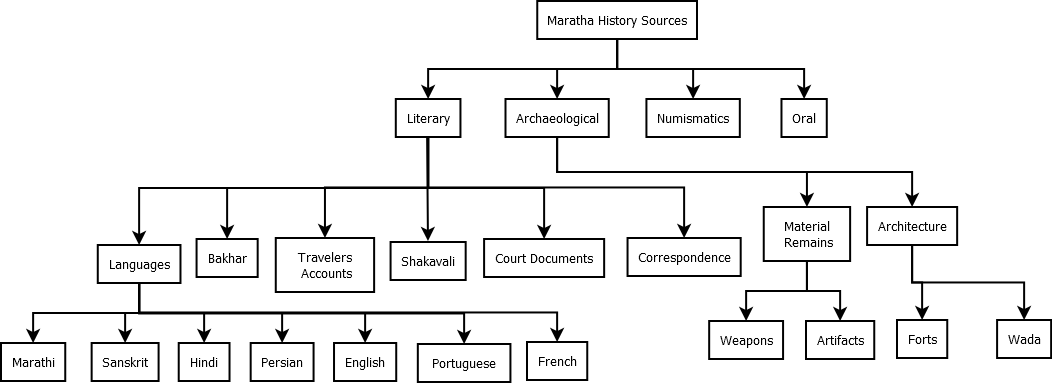
Sources for Maratha History
During the period from 1630 to 1818, is crucial in Indian History, since it experienced enormous military, political, economic, and social changes. Maratha State played significant role in this transition period. Personalities like Chhatrapati Shivaji and Sambhaji Maharaj and Peshwa Bajirao I, contributed immensely in the formation and sustenance of Maratha State, that influenced Indian Subcontinent in various manner. Ideas like Swaraj and Maharashtra Dharma, inculcated in masses, possessed importance and relevance even in contemporary world.
Hence, understanding Maratha History through authentic and multiple sources is noteworthy.
Following mentioned sources for the study of Maratha History are divided in four types and are introductory and indicative in nature.
Literary: – Bakhar, Travelers accounts, Shakavali, court documents, Correspondence
Languages: sources for the study of Maratha History are available in Marathi, Sanskrit, Hindi, Persian, English, French, Portuguese, etc. for this introductory information purpose, some sources from Sanskrit language are mentioned below.
Sanskrit Language: Books like Shiv Bharat, Parnal Parvat Grahan Aakhyan, Radha Madhav Vilas Champu, and Rajyavyavahar Kosh, etc. These sources throw important light on the concerned subject of the Maratha period.
Bakhar: this is one of the prominent types of sourse available for the study of Maratha History, like Sabhasad Bakhar, Chitnis Bakhar, Peshwanchi Bakhar, etc. Bakhar were written in prose format and subject matter of the Bakhar could be an incident like Panipat Bakhar or related to biographical sketch of prominent personality or family.
Travelers Account: during this period travelers from different parts of the world visited Deccan like John Fryer, Abbe Carre, Nicolai Manuchi, etc. accounts of these travelers gives different perspective towards Maratha History.
Shakavali: as the name suggest record of events with dated mentioned as per Shaka era, hence Shakavali. There are Jedhe Shakavali, Rajyabhishek Shakavali, Shahji Kalin Shakavali, etc., are available for the study of Maratha period. These are important in understanding chronological and corroborative aspect of sources available for the Maratha History.
Court Documents: Daftar; various court proceedings placed during this time period at different courts Maratha State Sardars and Provincial and District in-charge like Peshwe Daftar, Patwardhan Daftar, etc. these are crucial in understanding the workings of Maratha State.
Correspondence: this is important source as it conveys one to one dialogue between parties involve in event. Person to person or State to Person or One State to another State. These different types of correspondence give valuable information about the Maratha History.
Archaeological: – material remains, weapons, forts, Wada.
Material remains: Various utensils and objects in use during Maratha period gives information about lifestyle as well as technological and scientific progress of that period.
Weapons: Military activities contains the visible and sizeable portion in concern of the Maratha history. Hence the weapons become rather more important source for the study. It gives valuable insights into the nature of warfare as well as metallurgical knowledge of the concerned period.
Forts: Mountain range of Sahyadri and forts build on it are the backbone of the emergence and success of Maratha State as it facilitated security of State as well as favorable for the Gorilla Warfare. Maratha Period witnessed the optimum use of fort architecture; hence forts are important as source for the study of Maratha Period.
Numismatics: – study of coins during Maratha period gives insights into the technological and economic conditions of the period. The size, material of coins is crucial to infer the prosperity of State. Content inscribed on coins are important source for history.
Oral: – folklore, Powada
In concern of Maratha period folklore and ballads played valuable role as it take ideas of prominent personalities and institutions to the common people and make that idea part of memory.